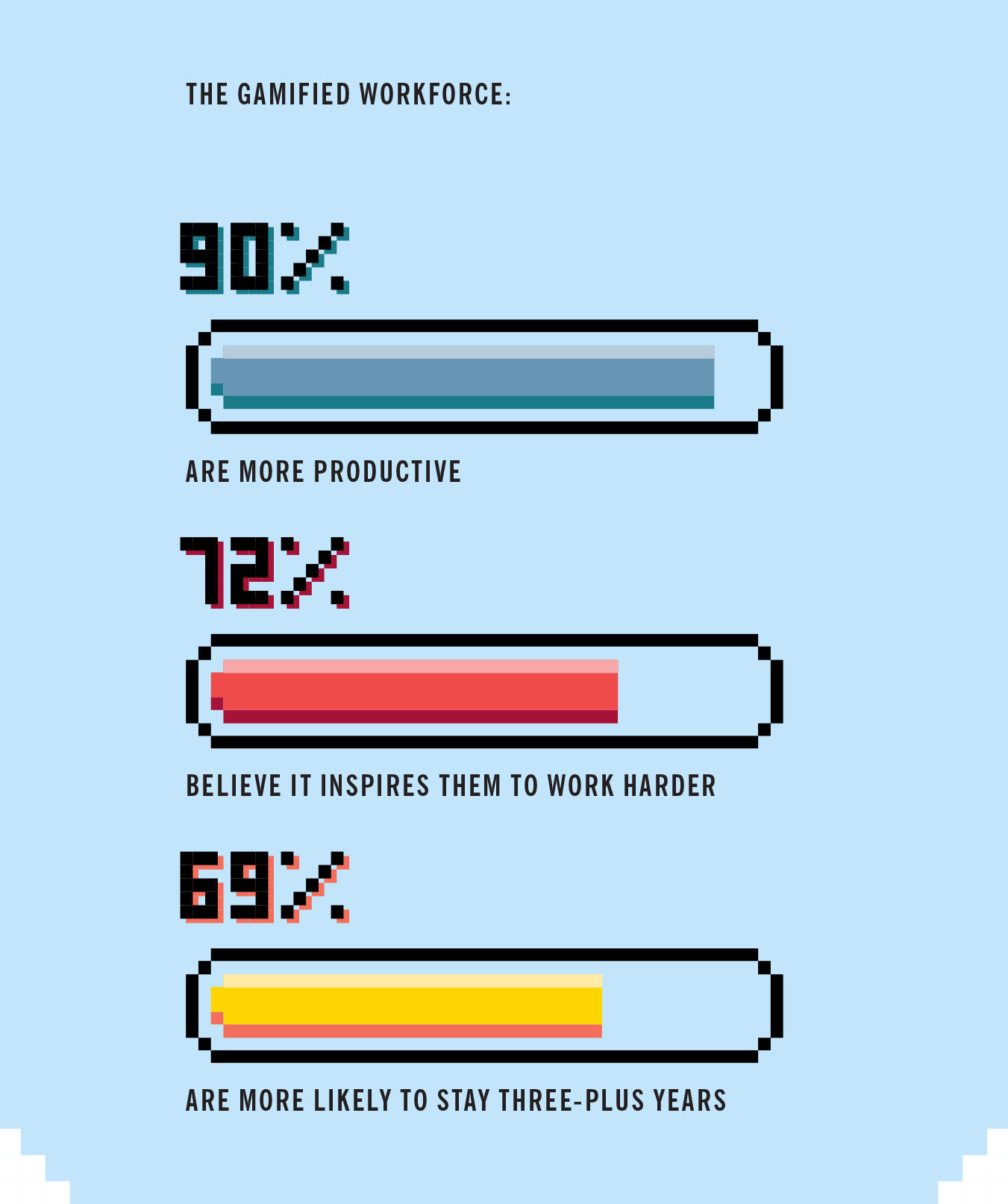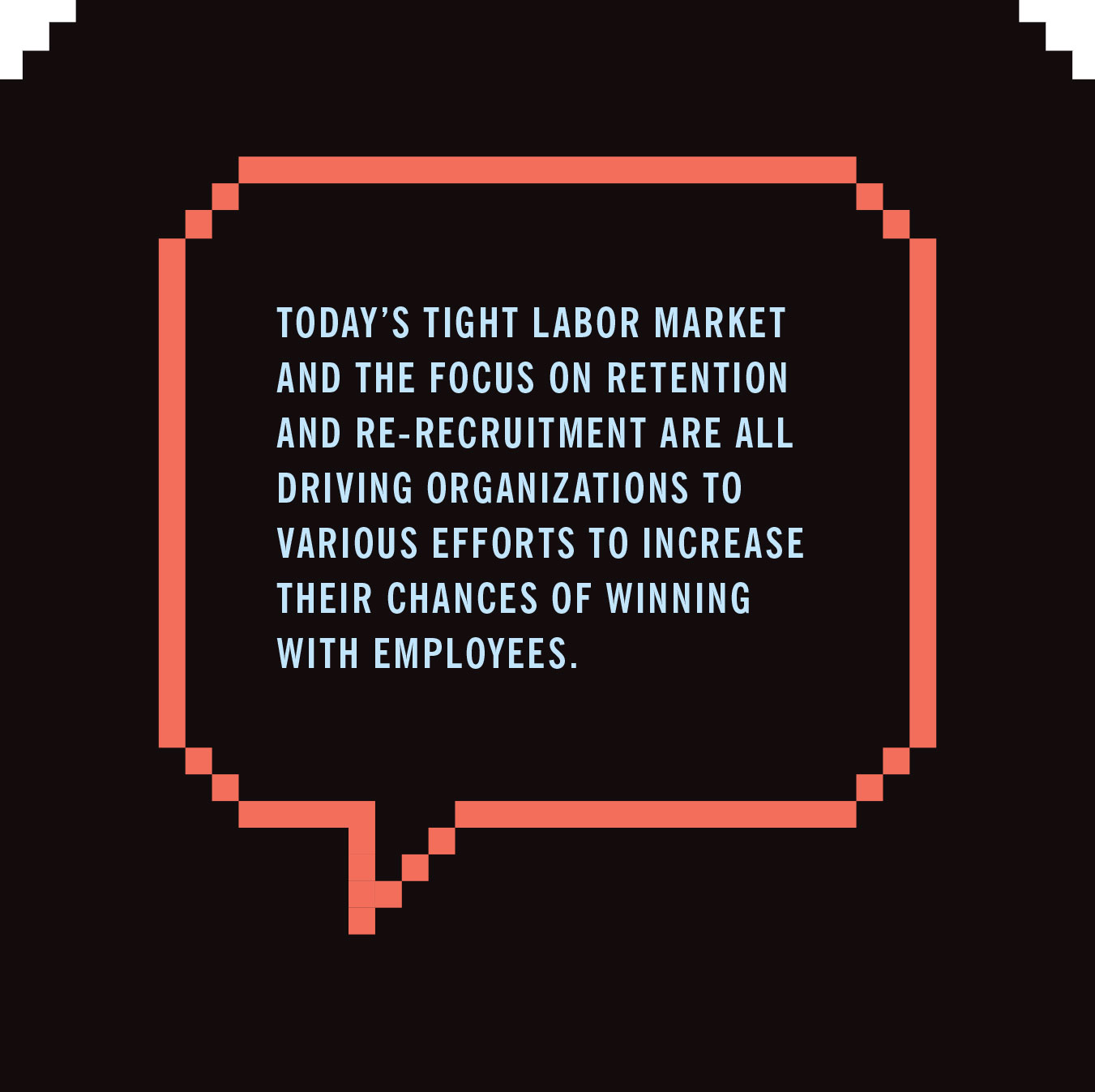Just like the terms “blockchain” or “cloud,” “gamification” is becoming overused and misunderstood business jargon. The reason terms like these are overused in corporate settings is not because the ideas don’t drive value, but because the concepts are often misunderstood as to when is best to utilize these strategies. To make sure you are using the term correctly, let’s understand what gamification is, why it works, what value it provides, and how to best utilize the concept inside your organization.
Merriam-Webster defines gamification as “the process of adding games or game-like elements to something (such as a task) so as to encourage participation.” For business purposes, we would like to narrow this definition slightly to say “Gamification is the process of applying virtual game-like elements to encourage specific behaviors in real-world activities.” The key differences here are “virtual,” “game-like,” “specific behaviors,” and “real-world activities.” All four are key elements of how and why you will want to use gamification in a business setting.
“Virtual” is a given these days in a business environment. Why run a manual process when an online system can be so much more efficient, especially when your teams are not localized to a single office? And while everybody likes to have fun, the end goal of every organization is to drive results. The goal of gamification is not to add games to your processes (you don’t need to build the next Space Invaders franchise), but to add “game-like” elements to encourage “specific behaviors” from your workforce that are focused on the “real-world activities” that drive your specific business goals.
It is important to note that gamification itself is not a new concept, just a new term used to describe the mass digitization of the idea. In the past, gamification was commonly found in the automotive, software, and retail industries as it relates to sales targets and roles. It grew from there and today applies to apply to any role that had quantifiable metrics, such as safety or defect metrics on manufacturing lines. In today’s competitive job market, Talent Acquisition teams are amping up their gamification efforts to spur on higher throughput of candidates.

While those examples of gamification are tied tightly to corporate metrics, others are all about driving a shift in behavior. A great historic example of gamification that most should be familiar with is the model used by the Girl Scouts. From receiving badges for specific activities to cookie sales competitions and leveling up from Daisy to Brownie and so on, the Girl Scouts is a classic example of an organization using offline gamification to drive real-world behaviors.
Whether a group of Girl Scouts or employees, from a biochemical perspective, gamification works by engaging users (through rewards, competitions, and leveling up), which excites them with a release of dopamine that leads to an increase in motivation and repeat behavior. So, when creating a gamification strategy for your organization, it is critical to understand what drives a user to participate so you engage them with the best strategy to encourage the specific behaviors for the real-world activities you want to enrich. User motivation can either be intrinsic, where enjoyment and interest drive engagement, or extrinsic, where participation is driven by external rewards or validation. Gamification users who focus on intrinsic motivators engage to feel like part of a community, learn new skills, showcase their specific mastery, and experience autonomy. Those users who focus on extrinsic motivators prefer a more competitive style of gamification, participating for points, badges, rewards, and recognition.

Many organizations already use elements of virtual and offline gamification tactics with their internal employees in areas such as sales, training, onboarding, engagement, and change management. Very few, however, have a holistic, virtual gamification strategy that unifies the entire workforce to focus on the most critical organizational goals. It is already reported that when aspects of employees’ work activities are gamified, 90 percent are more productive, 72 percent believe it inspires them to work harder, and 69 percent are more likely to stay three-plus years with the organization.1
Today’s tight labor market and the focus on retention and re-recruitment are all driving organizations to various efforts to increase their chances of winning with employees. Yet, with such high statistics of success, why is gamification one of the most underutilized levers an organization pulls to increase engagement? Barriers to entry may include underestimating the value of gamification on engagement, so it’s not given priority; negative perception of “games at work”; fear of cumbersome process and technology implementations; and sense of not having time to develop a strategy, let alone implement one.
Here is why we believe every organization needs to view employee engagement differently, and by extension, consider gamification as a lever to pull to improve it. The shift in workplace longevity over the last 20 years has been dramatic. Forbes recently reported that “While the average employee once stayed around five years in a role, a 2021 report from the Bridge Group found tenure today to be as low as only 1.8 years.”2
The bottom line is that no one is staying at an organization very long. When great leaders within an organization leave, oftentimes their people will follow them or leave in search of other opportunities now that their anchor has left. With this in mind, it is important to focus on building the organization and culture to be agnostic of the people who may come and go. This is where gamification systems come into play. If you can shift the connection from one leader, who might leave an organization, to a system of the leader and the organization, it can alleviate the dependency on the leader and place it primarily on the system.
When Jabian talks about engagement, we think of it in terms of our Engagement Framework. The engagement drivers of Relationships, Autonomy, Fairness, Well-being, Security, and Growth are the motivators and emotional drivers of engagement in an organization. You improve both employee experience and achieve better business results by creating a full ecosystem where everyone is playing the same game, regardless of function, to drive behavior.3
Gamification can positively impact two-thirds of the Engagement drivers listed above. Relationships, Growth, Well-Being, and Security can be positively nurtured via gamification. It is important to be aware of the two engagement drivers that could be negatively impacted by gamification — Fairness and Autonomy. Gamification might highlight disparities that were previously invisible outside of a function, resulting in a perception of unfairness. Additionally, if everyone is required to participate in the game, there could be a perception of lost autonomy. These challenges can be addressed in the system design.
Data proves that high engagement drives better business results, including increased retention:4
- U.S. employers spend $2.9M per day looking for replacement talent.
- Sixty-nine percent of employees say greater appreciation would motivate them to work harder.
- Organizations with a highly engaged workforce can see 41 percent lower absenteeism, are 21 percent more profitable, and are 17 percent more productive.
Making a holistic workforce gamification strategy a top priority is a key approach to tackling the tight labor market of today and creating a culture that acts as an anchor for your employees of the future.
You can leverage gamification to increase engagement and ultimately reach your business goals and objectives. Our goal is to help you lower the barrier to entry of gamification and help you think about leveraging games differently.
Sources:
- https://www.linkedin.com/pulse/how-gamification-can-improve-employee-performance-wesoar/
- https://www.forbes.com/sites/forbestechcouncil/2021/07/28/why-your-employees-are-leaving-en-masse-and-the-surprising-factor-that-will-keep-them/?sh=69828ae240fb
- https://journal.jabian.com/exploring-the-dynamics-of-employee-engagement/
- https://haiilo.com/blog/employee-engagement-8-statistics-you-need-to-know/</
